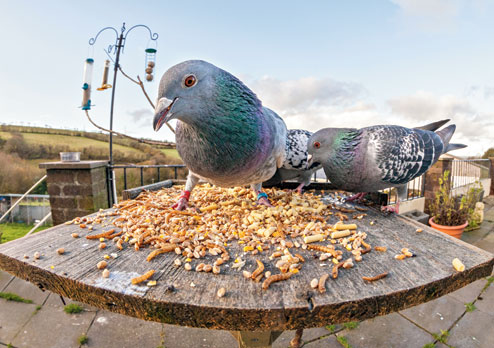With cities turning into concrete jungles and the natural habitats of birds disappearing, winged creatures have to find new destinations to build nests. And your garden could be just that.
Birds are generally adaptable and learn quickly how make the best of this new habitat. Most garden birds were originally woodland species and it is observed that the man-made environment is even more suitable than their woodland haunt.
However, the potential of a garden for birds is entirely dependent on its owner’s attitude. With a little effort and thought and by studying the behaviour of some common birds that live around us, you can create a garden that attracts many a bird.
Gardening for birds is a compromise between creating a garden that we find aesthetically pleasing and one that birds find useful. But with a little imagination it is possible to combine both.

For a comfortable home
To design a garden for birds we must first understand their nest.
The nest is a structure used almost exclusively for protecting the eggs and newborns. Sometimes it is used as resting places too. The physiological changes that take place in the bird’s body in the reproductive period determine the construction of nests. Most species need to build new nests every year.
The variety of nests in the world of birds is fascinating. The choice of site, materials used, the time taken to build it and the activities of the males and females in the construction, all vary from species to species.
Some species build elaborate structures, whereas some small species like Tailor Birds (Tuntuni) build their nests out of parts of plants. They would lay dried leaves and barks so they can hold the weight of their eggs, they would tear long leaves into strips and use them as threads to sew it all together.
When planning a bird garden there are three requirements that must be provided: food, shelter and nesting facilities.

a Dracaena plant
Food: Birds become regular visitors if you routinely leave out suitable food and water for drinking and bathing and proper nesting facilities. For this ensure there is a lawn, hedges, annuals, flowering shrubs and fruit trees etc. And you needn’t built a very large garden; a bird haven can be created even in a very small front garden or in a terrace garden.
A lawn, no matter how small, is a great asset to a bird garden. Although grass itself is not a bird food, its seeds are eaten by finches and sparrows. The worms and insect larvae in the soil attract Thrushes, Common Myna, Woodpecker etc.
On a hot summer day a fine lawn spray will not only water the grass but will attract birds which like to bathe and feed on the worms that came to the surface.
Birds are attracted by such annuals as Antirrhinums, Asters, Phlox, Poppies, Corn Flower, Violas, Nasturtium, Delphinium, Larkspur and Stock etc. If properly planned, a mixture of annuals may create a spectacular garden.
Some Daisy-like flowers like Cosmos supply good seeds for birds. The oil-rich seeds of Sunflowers are a favourite for many birds like the Rose Ringed Parakeet. Nasturtiums have pointed sacs behind the flowers that are a reservoir of nectar and are devoured by long-beaked birds like Sunbirds.
An orchard with fruit-bearing trees like Guava, Ber, Chiku, Pomegranate etc. will attract fruit eating birds like Bulbul and Parakeet and will also provide them excellent shelter.
Water always attracts birds so a small pool may be included, with a gentle slope on one side for bathing area of birds. Water plants like Water Lilies can be planted too.
Feeding the birds may be an important way of helping them survive. It is also one of the easiest ways to attract birds to the garden.

hollow by birds
Shelter: The best way to feed birds is to place a bird-table in the garden. A simple flat plate with square battens around the edge to prevent food rolling off is quite adequate.
Always mount a bird-table on a smooth pole, about one-and-a-half metres above the ground as it would be difficult for cats and squirrels to climb. It should be in a sheltered place fairly close to a hedge, so birds can make hasty retreat as and when required.
Some birds are reluctant to feed at such elevated heights so always sprinkle some food on the ground too.
Specially-prepared commercial bird foods have a balanced composition and cater for all birds’ tastes. But they are expensive. A mixture of natural seeds, fruits and berries is just as nourishing and cheaper.
Nesting facilities: Many gardens have a shortage of nest sites and this can be solved by providing suitable artificial nesting boxes. These boxes need not be expensive. They may be made easily out of plywood and packing boxes. Even an empty shoebox with suitable nesting holes may be used as a nesting box.
They must be of the right size, shape, be water-proof and well-ventilated. Custom-made nesting boxes are also available in nurseries.
It is difficult to state categorically how many boxes are needed in a garden as it depends on the availability of natural nest sites around the garden. But the box should be placed high enough so that cats and other animals cannot reach it.
The positioning of the box is crucial. It must be sheltered from westerly winds and the full blaze of the sun. Always remember to tilt the box forward slightly for proper drainage.
Peace and quiet
If birds do nest in the garden try to cause as little disturbance as possible. You can watch them building their nests and feeding their young ones but you must take care to keep still and not go near them. If they feel disturbed, they will desert the nest.
By providing food and nesting boxes for birds you will notice many types, even the very shy ones, coming near you. You are in fact setting up a bird refuge, commonly called a bird sanctuary, in your garden where they will be safe from harm, protected from hunters and marauders.
Before concluding, I wish to share an interesting experience with the readers of The Telegraph Salt Lake. Every year for the last four years a pair of Tailor Birds (Tuntuni) come and build nests on different plants of my terrace garden.
But this year a pair has built a nest on a Dracaena plant in my driveway. It is visible straight from my writing table and it is thrilling to watch them work so hard and persistently to complete the nest in time for laying eggs. The nest is about 1m from the ground and even as I write I can hear them chirping cheerfully and squeaking.
Although there are lot of plants in my driveway, it is not devoid of city noises and the occasional honking. Yet it is heartening to see that the birds have come to build their nest in a Salt Lake garden.
Pictures: Saradindu Chaudhury
To be continued










